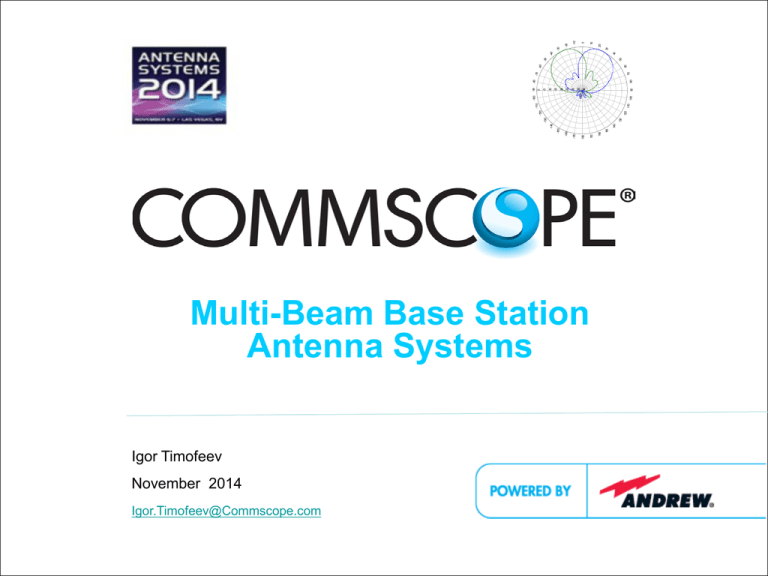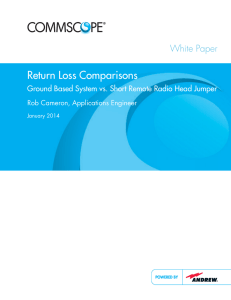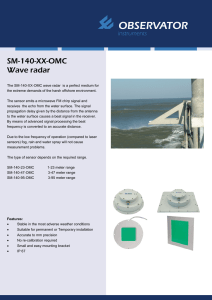
20
30
0
10
-10
-20
-30
40
-40
50
-50
60
-60
70
-70
90
-40
-35
-30
-25
-20
-15
-10
80
-80
0
-5
-90
100
-100
110
-110
120
-120
140
150
160
170
180
-170
-160
-150
-140
130
-130
Multi-Beam Base Station
Antenna Systems
Igor Timofeev
November 2014
Igor.Timofeev@Commscope.com
PRIVATE AND CONFIDENTIAL. Copyright © 2014 CommScope, Inc. – All rights reserved.
1
Agenda
Introduction: Multi-beam antennas in wireless communications.
Part 1: Butler Matrix Base Station Antennas
• Review of BFNs: classic Butler matrix, modified Butler matrix, Blass Matrix, Rotman lens.
• Examples of Commscope multi-beam antennas (2-, 3-, 18-beams, 2-band 2-beam).
• Methods of bandwidth increasing for Butler matrix multi-beam antenna arrays.
Part 2: Lensed Multi-Beam BSA
• Review of lensed multi-beam antennas (Luneberg and homogeneous lenses).
• 3-beam lensed BSA.
• Bandwidth increasing for lensed multi-beam antennas.
• Comparison of Butler matrix and lensed solutions
PRIVATE AND CONFIDENTIAL. Copyright © 2014 CommScope, Inc. – All rights reserved.
2
Multi-Beam BSA to Boost Capacity
2 Beams
3 Beams
5 Beams
9 Beams
18 Beams
(2 x 38°)
(3 x 24°)
(5 x 12°)
(9 x 6°)
(2 x 9 x 6°)
HBXX-3817TB1-VTM
3-H24A-3XR
5NPX1006F
5UPX0805F
2x9NPA2010F
• More capacity due to increased
sectorization
2x9NPA2010F
• Could be horizontal and vertical
sectorization
• Ideal solution for high traffic
sectors and events
• Opportunity: switch beam to
provide the best signal for the user
(smart antenna)
• Opportunity for coverage sculpting
•
MIMO; massive MIMO
PRIVATE AND CONFIDENTIAL. Copyright © 2014 CommScope, Inc. – All rights reserved.
3
Part 1: Butler Matrix BSA Arrays
Examples of Beam-Forming Networks
Directional coupler
Boresight beam
5x5 Blass matrix, 1960
2x3 Butler-style
matrix, 2005
2x4 Butler-style
matrix, 2005
3dB Hybrid
16x20 Rotman,
lens, 1963
6x6 Butler
style matrix,
2005
8x8 Butler matrix, 1961
PRIVATE AND CONFIDENTIAL. Copyright © 2014 CommScope, Inc. – All rights reserved.
4
HBXX-3817TB1-VTM Twin Beam Antenna
2x4 Butler matrix
2x3 Butler matrix
Phase shifter
0.00
2-pol dipoles (34EA)
-5.00
Measured Az patterns
@ 1.7 - 2.2GHz
SLL <-20dB
-10.00
Measured El patterns
@ 1.7 - 2.2GHz
0 and 10⁰ beam tilt
-15.00
2.2GHz
1.7GHz
-20.00
-25.00
-30.00
-35.00
-40.00
-180
-150
-170
-160
-110
-130
-140
-120
-90
-100
-50
-70
-80
-60
-10
-30
-40
-20
30
10
0
20
50
40
90
70
60
80
130
110
100
PRIVATE AND CONFIDENTIAL. Copyright © 2014 CommScope, Inc. – All rights reserved.
120
170
150
140
160
180
5
2x9-Beam Stadium Antenna 2x9NPA2010F
Frequency
Band, MHz
1710–
1920
1920–
2170
25.0
27.0
6
5
Beamwidth,
Vertical, degrees
7.2
5.8
USLS, dB
18
18
Front-to-Back
Ratio at 180°,
dB
30
30
Gain, dBi
Beamwidth,
Horizontal,
degrees
View from behind antenna
looking outward:
8°
~90°
Horizontal and vertical
sectorization is used
Isolation, dB
16
16
VSWR | Return
Loss, dB
1.43 |
15.0
1.43 |
15.0
PIM, 3rd Order,
2 x 20 W, dBc
-150
-150
PRIVATE AND CONFIDENTIAL. Copyright © 2014 CommScope, Inc. – All rights reserved.
100 of 2-pol radiating
elements located
in triangular lattice
6
2-band 2-Beam Antenna 2UNPX206.12R2
698-894 + 1710-2170MHz
25% bandwidth in both bands
PRIVATE AND CONFIDENTIAL. Copyright © 2014 CommScope, Inc. – All rights reserved.
7
Challenges and Solutions for Wideband Array
Challenges
Solutions
• Simple Butler matrixes (shown in slide 5)
are working OK for relatively narrow
band (say, 1.7-2.2GHz, see slide 5,6)
•
•
Introduction of new bands (LTE2.6 and
LTE3.5) requires wider bandwidth 1.7 2.7 GHz (or even 1.7-3.8GHz) causes
significant beam width and beam
position variations, SL increasing
Narrowing beam effect
Beam walking effect
Solution 1: make amplitude distribution
in antenna array depending on frequency:
- filters;
- frequency dependent power dividers;
- Solution 1 adds complexity: about 3
times more components
• Solution 2: lensed antennas (see Part 2)
Grating lobes\side lobes
1.7-2.1GHz
φ
2.5 -2.7GHz
Dual Band Interleaved Base Station Phased Array Antenna With
Optimized Cross-Dipole and EBG/AMC Structure. Fayez Hyjazie, Paul
Watson, and Halim Boutayeb, IEEE AP-S, Memphis, 2014, p. 1558
PRIVATE AND CONFIDENTIAL. Copyright © 2014 CommScope, Inc. – All rights reserved.
Frequency-dependent
divider
8
2-Beam Wideband Antenna Array
1.7 – 2.7 GHz array
“Clover” dipole and tightly
coupled dipoles are candidates
for ultra-wideband 2-beam
Frequency-dependent
divider
PRIVATE AND CONFIDENTIAL. Copyright © 2014 CommScope, Inc. – All rights reserved.
9
Part 2: Lensed Multi-Beam BSA
RF lenses: A Lot of Defense Applications, New for BSA
Homogeneous
lens
Multi-layer Luneberg
Lens: ε = 2 – (r/R)²
PRIVATE AND CONFIDENTIAL. Copyright © 2014 CommScope, Inc. – All rights reserved.
Example:
Radar jamming
32 beams
2-pol
50% bandwidth
Late 70s
10
3-H24A-3XR: High Performance Tri-Beam
· 1710–2180 MHz
• 3 x 24º beams
• 10 dB roll-off between sectors
• Gain ~22 dBi
• <-18 dB horizontal sidelobes
• Cross-pol ratio > 10dB over cell sector
• Individual remote electrical tilt (RET)
0- 10⁰ for each of 3 beams
• >30dB isolation between all ports
• Use of artificial dielectric (US patent
8518537) significantly reduce antenna
weight and cross-polarization level
• Low wind load (3 times less compare to
equivalent Butler matrix array)
Cell plan and sectorization
resulting from 3-beam
lensed antennas
Cross-pol
PRIVATE AND CONFIDENTIAL. Copyright © 2014 CommScope, Inc. – All rights reserved.
11
Wideband Tri-Beam 1.7 – 2.7GHz
•
Stable azimuth beamwidth: 23+/-2⁰ (-3dB
level); 40+/-3⁰ (-10dB level)
Box-type element itself
• Stable beam position (+/-1.5⁰ of nominal) and
beam cross-over -10+/-3dB
-3dB
-10dB
• Low azimuth sidelobes, decreased elevation
grating lobes (by ~5dB)
• 120⁰ coverage, 3 antennas only per cell site
–
-3dB
4 beam (with the same lens): 180⁰ coverage,
only 2 antennas per cell site
W/o lens
1.7GHz
2.2GHz
2.7GHz
With lens
Measured patterns
Phase shifter+actuator
• With the same lens and the same size, 4-beam can
obtained: only 2 antennas per cell site for 360⁰ coverage
PRIVATE AND CONFIDENTIAL. Copyright © 2014 CommScope, Inc. – All rights reserved.
12
Wideband and Dual-Band Lensed Antennas
• Beam position for lensed antenna does not depend
on frequency; but need take care about beamwidth.
•
Beam width stabilization can be achieved by using
antenna element with beam width monotonically
decreasing with frequency. Example: box-type
element.
• In the result, lens effective radiating aperture is also
decreasing with frequency and beam of whole
antenna is not depending on frequency.
•
f₁
2-band array solution is shown below: box-type
elements for low band (LB, 698 – 960MHz) plus
combination of box elements and pairs of crossdipoles for HB (1.7 -2.7GHz).
LB
f₁ < f₂ ; S₁ > S₂;
if S₁ / S₂ = λ₁ / λ₂, Az BW = const
f₂
HB
Example of 2-band feed array for dual-band lensed antenna
PRIVATE AND CONFIDENTIAL. Copyright © 2014 CommScope, Inc. – All rights reserved.
2-pol box-type antenna element is candidate
for wideband and dual-band lensed antennas
13
Performance Comparison
A lensed BSA has the following performance
advantages over planar array Butler matrix
technology:
• Higher gain efficiency (less insertion loss)
• Exceptional port-to-port isolation (typically,
10 -15dB better)
• No pattern distortion or scanning gain loss
for outer beams
• 25 -30% narrower (with the same Az BW)
•
Significant (3 times) lower frontal and rear
wind load (thanks to rounded shape and better
A lensed BSA has the following
performance disadvantages
over planar array Butler matrix
technology:
• 1.5 – 2 times deeper
• 30% - 50% higher
lateral wind load
aperture efficiency)
•
•
•
•
•
Lighter weight (typically, by 30%)
Excellent independent beam tilt
performance; extended tilt OK (say, 0-20⁰)
Excellent stability of beam cross-over level,
beam pointing and beam roll-off
Excellent azimuth and elevation sidelobe
suppression (grating lobes)
Wider max coverage (180⁰ typ. vs. 100⁰ typ.
for cylindrical; up to 360⁰ for spherical lens)
PRIVATE AND CONFIDENTIAL. Copyright © 2014 CommScope, Inc. – All rights reserved.
14
Thank-you!
Questions?
PRIVATE AND CONFIDENTIAL. Copyright © 2014 CommScope, Inc. – All rights reserved.
15
PRIVATE AND CONFIDENTIAL. Copyright © 2014 CommScope, Inc. – All rights reserved.
16




